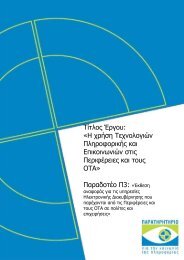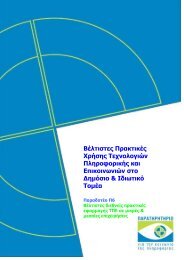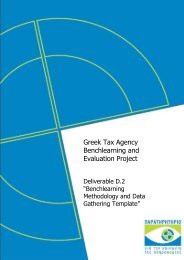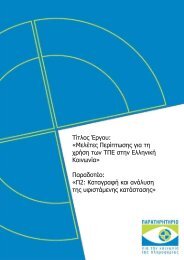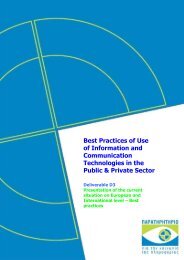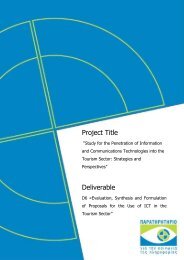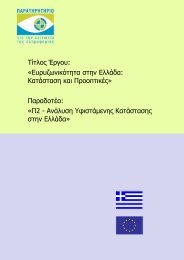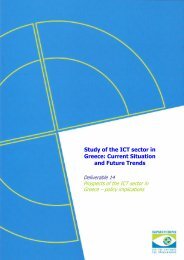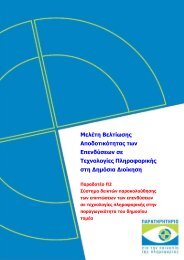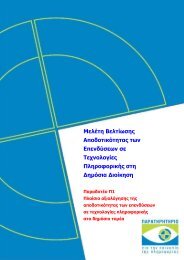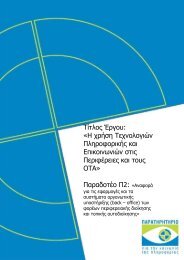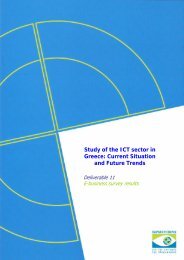Project management and the private finance initiative
Project management and the private finance initiative
Project management and the private finance initiative
You also want an ePaper? Increase the reach of your titles
YUMPU automatically turns print PDFs into web optimized ePapers that Google loves.
chapter four<br />
Survey of RICS <strong>Project</strong> Management Faculty Members<br />
4.1 Introduction<br />
A questionnaire was developed in parallel with <strong>the</strong> interviews<br />
to ascertain what proportion of <strong>Project</strong> Management Faculty<br />
members are involved in PFI projects, in what capacity, <strong>and</strong><br />
<strong>the</strong>ir background, skills <strong>and</strong> experience. The questionnaire was<br />
designed to be completed over <strong>the</strong> Internet <strong>and</strong> <strong>the</strong> research<br />
population comprised those Faculty members for whom <strong>the</strong><br />
RICS had an email address.<br />
The survey was undertaken by sending an email (containing a<br />
hyperlink to <strong>the</strong> questionnaire) to each member of <strong>the</strong> research<br />
population. Recipients were given two weeks in which to<br />
complete <strong>the</strong> questionnaire, a copy of which is included in<br />
Appendix F.<br />
A total of 701 responses were received, representing a response<br />
rate of just over 4% 14 . Although this is relatively low, it should be<br />
remembered that PFI is a specialist subject area <strong>and</strong> may <strong>the</strong>refore<br />
be of interest to only a small proportion of <strong>the</strong> Faculty membership.<br />
In order to elicit fur<strong>the</strong>r information on <strong>the</strong> skills issue, a follow-up<br />
online questionnaire was developed for non-PFI-active respondents.<br />
This survey received 83 responses, <strong>and</strong> so care should be taken in<br />
interpreting <strong>the</strong> results from <strong>the</strong> follow-up survey.<br />
4.2 Background of respondents<br />
The majority of respondents were male (90%). This is comparable<br />
to <strong>the</strong> figure for <strong>the</strong> RICS membership (88%), but lower than <strong>the</strong><br />
figure for <strong>the</strong> Faculty Membership (95%) (Pottinger et al., 2001).<br />
Some 43% of respondents were aged between 36 <strong>and</strong> 49, but<br />
only 6% were under 26 years of age. Female respondents were<br />
most represented in <strong>the</strong> lower age groups. Some 29% of those<br />
under <strong>the</strong> age of 26 were females. However, in <strong>the</strong> 36–49 <strong>and</strong><br />
50–64 age groups <strong>the</strong> proportion of female respondents dropped<br />
to 7% <strong>and</strong> 3% respectively.<br />
Nearly two-thirds of respondents (64%) held a first degree (BA or<br />
BSc). Additionally, 10% of respondents held a masters’ degree<br />
(MA or MSc), 7% a Diploma in <strong>Project</strong> Management <strong>and</strong> 4% a Master<br />
in Business Administration (MBA). First degrees were most common<br />
amongst <strong>the</strong> younger age groups. Of <strong>the</strong> 21–25 year olds, 81%<br />
held a first degree, compared with only 59% of 36–49 year olds.<br />
Female respondents were more likely to hold a first degree (80%<br />
compared with 63% of males). Female respondents were also<br />
more likely to hold a masters’ degree (12% compared to 9%), but<br />
were less likely to hold a MBA (1% compared to 4%).<br />
All respondents were members of <strong>the</strong> RICS. Some 18% were<br />
members of <strong>the</strong> Chartered Institute of Building (CIOB) <strong>and</strong> 10%<br />
were members of <strong>the</strong> Association of <strong>Project</strong> Managers (APM).<br />
Very few respondents belonged to o<strong>the</strong>r organisations, such as<br />
<strong>the</strong> RIBA (1%), CoreNet (0.6%) or <strong>the</strong> Chartered Institute of<br />
Arbitrators (6.5%). Professional memberships tended to be more<br />
common amongst <strong>the</strong> older age groups. Taking <strong>the</strong> CIOB as an<br />
example, 20% of 36–64-year-olds were members, compared to<br />
just 7% of those under 26 years of age.<br />
The majority of respondents were from one of four different<br />
types of organisation (Figure 4.1). The largest proportion was<br />
from multi-disciplinary surveying practices (20%) <strong>and</strong> quantity<br />
surveying practices (16%), but <strong>the</strong>re were also substantial<br />
numbers from construction companies (14%) <strong>and</strong> local<br />
government (14%). Only 7% of respondents worked for a project<br />
<strong>management</strong> practice. The data can be compared to those<br />
collected in a previous survey of Faculty members (Pottinger et al.<br />
(2001), <strong>the</strong> data from which are also shown in Figure 4.1. In <strong>the</strong><br />
present survey <strong>the</strong>re was a lower proportion of multi-disciplinary,<br />
quantity <strong>and</strong> o<strong>the</strong>r surveying practice employees as well those<br />
working for corporates / Plcs. In contrast <strong>the</strong>re was a higher<br />
proportion of individuals from construction companies, local<br />
government <strong>and</strong> project <strong>management</strong> practices. This is likely to<br />
reflect <strong>the</strong> subject area of <strong>the</strong> questionnaire ra<strong>the</strong>r than a shift in<br />
<strong>the</strong> characteristics of <strong>the</strong> Faculty’s membership over <strong>the</strong> last two<br />
years. Overall <strong>the</strong> data shows that 73% respondents were based<br />
in <strong>the</strong> public sector <strong>and</strong> 20% in <strong>the</strong> <strong>private</strong> sector (for 7% of<br />
respondents <strong>the</strong>ir background was unknown) 15 .<br />
14 Although this is a relatively low response rate we are confident that <strong>the</strong> sample is a representative view of <strong>the</strong> Faculty members <strong>and</strong> <strong>the</strong> profile approximately matches <strong>the</strong> previous<br />
2001 survey. It was not possible to examine <strong>the</strong> reasons for non-response.<br />
15 Similar figures were found for <strong>the</strong> PFI active <strong>and</strong> non-active groups.<br />
19 chapter four Survey of RICS <strong>Project</strong> Management Faculty Members <strong>Project</strong> <strong>management</strong> <strong>and</strong> <strong>the</strong> <strong>private</strong> <strong>finance</strong> <strong>initiative</strong>



